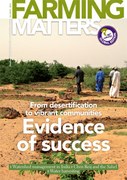(December 2012) David Millar looks at some of the obstacles to tree-planting in northern Ghana and identifies other strategies for combating climate change.Better grassland management provides an opportunity for northern Ghana to participate in the global efforts to reduce carbon dioxide emissions, benefit from the Clean Development Mechanisms (CDM), provide income generation opportunities and efficiently contribute to the fight against desertification.
Within the current debates on climate change, tree planting has received much attention world-wide, and has been a major strategy of the forestry and environmental sectors in Ghana. However, in northern Ghana, there are several obstacles to developing tree planting programmes.
First, when arable land is in short supply, it is difficult to set aside land for tree cultivation. This is a major issue in the Upper East region in particular. Even in the Northern and Upper West regions, which have lower population densities, bush fallow periods are getting shorter and shorter, and there are many demands to release land belonging to game and forest reserves.
The annual bush fires make tree planting difficult, as it is almost impossible to protect the trees from the fires. Thirdly, eucalyptus, the major tree being promoted, is non-indigenous and is a “thirsty tree”, which has serious implications for ground water availability in an already water deficient region. Furthermore, eucalyptus monocultures reduce biodiversity.
Finally, there are several cultural barriers to planting some species of trees. All these factors reduce the opportunities to plant trees in northern Ghana and to take advantage of the “emission trading” provisions under the Kyoto protocols.
In the Upper East region of Ghana, basket weaving is an important income generating activity. The grasses used are obtained from the wild. However, changing rainfall patterns, bush fires and an increasing demand have substantially reduced the availability of the grasses used, to the extent that they need to be imported from other regions. These grasses are particularly tall and can also be used to reclaim wastelands, and can provide the basis for setting the pace and extent of bush fires.
For instance, in areas where grasses are used for roofing, burning is often controlled until the required amounts have been harvested by all who need it. This has other benefits, leading to reductions of run-off and improvements in soil fertility, especially when the left-over grasses are left to decompose. Livestock depend on grasses for feed. Grasses can also be transformed into a form of charcoal (briquettes), with large economic benefits.
Better grassland management provides an opportunity for northern Ghana to participate in the global efforts to reduce carbon dioxide emissions, benefit from the Clean Development Mechanisms (CDM), provide income generation opportunities and efficiently contribute to the fight against desertification.
David Millar
David Millar is the Director of the Centre for Cosmovisions and Indigenous Knowledge in Tamale, Northern Region, Ghana, and Pro Vice Chancellor of the University for Development Studies.
E-mail: millarad1@yahoo.com

